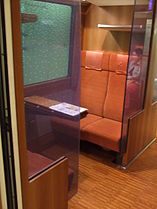Japanese EMU trainset
.mw-parser-output .hidden-begin{box-sizing:border-box;width:100%;padding:5px;border:none;font-size:95%}.mw-parser-output .hidden-title{font-weight:bold;line-height:1.6;text-align:left}.mw-parser-output .hidden-content{text-align:left}You can help expand this article with text translated from
the corresponding article in Japanese. (December 2021) Click [show] for important translation instructions.
Machine translation, like
DeepL or
Google Translate, is a useful starting point for translations, but translators must revise errors as necessary and confirm that the translation is accurate, rather than simply copy-pasting machine-translated text into the English Wikipedia.
Do not translate text that appears unreliable or low-quality. If possible, verify the text with references provided in the foreign-language article.
You must provide
copyright attribution in the
edit summary accompanying your translation by providing an
interlanguage link to the source of your translation. A model attribution edit summary is Content in this edit is translated from the existing Japanese Wikipedia article at [[:ja:小田急50000形電車]]; see its history for attribution.
You should also add the template ((Translated|ja|小田急50000形電車)) to the
talk page.
For more guidance, see
Wikipedia:Translation.
The Odakyu 50000 series (小田急50000形, Odakyū 50000-gata) or VSE (Vault Super Express) was an electric multiple unit (EMU) train type operated by Odakyu Electric Railway on Romancecar services in Japan. Two 10-car articulated sets were introduced in March 2005, manufactured by Nippon Sharyo.
The type won a Japanese Good Design Award in 2005, and a Blue Ribbon Award in 2006.[1]
On 11 March 2022, the train type was withdrawn from regular service, and reserved for use on special services only. The last trainset was retired on 10 December 2023.
Design
Designed by architect Noriaki Okabe,[2] the 50000 series was developed in response to a decrease in limited express service usage to the Hakone region.[3]: 1 Body construction consisted of double-skin aluminium.[2]
The 50000 series had regenerative brakes, and was equipped with air suspension and tilting for passenger comfort.
As with most previous Romancecar trains, the train cars in the sets were articulated.[4]
Interior
Passenger accommodation primarily consisted of 2+2 abreast seating, with a seat pitch of 1,010 millimetres (40 in) in the leading cars and 1,050 millimetres (41 in) in the intermediate cars. The seats were rotated five degrees toward the windows. In the leading cars, the frontmost seats could be arranged in a longitudinal, lounge-like configuration. Car 3 used compartment-style seating.[4]
The interior's vaulted ceiling was the namesake for the train type.[3]
The 50000 series trains' driver's cabs were located above the passenger saloon, giving passengers a view out of the front of the train.[4] This arrangement was used on earlier Odakyu Romancecar trains, although discontinued with the 30000 series EXE trains.[5]
-
View out of front of the train (there are sun visors in summer)
-
Saloon seating
-
Compartment seating
-
Former smoking booth (no longer used)
-
Retractable ladder providing access to the raised driver's cab
History
The first set was delivered from Nippon Sharyo in November 2004, and entered service on 19 March 2005.[6]
Withdrawal
Odakyu initially planned to refurbish the 50000 series trains.[7] However, as a result of the train type's overall difficulty to repair and advanced technology required to do so, Odakyu announced on 17 December 2021 its decision to retire them.[2] On 29 January 2022, set 50002 was adorned with decorations to commemorate the type's withdrawal.[8]
The trains were relegated from regular service to special service only on 11 March 2022,[9] and were planned to be completely retired in 2023.[10] On 23 and 24 September 2023, Odakyu held special group tours where the two VSE sets ran and passed each other side by side.[11] These were the final runs of set 50002, which was retired immediately afterwards.
In 2023, Odakyu announced that the last set, set 50001 would be retired in December of that year.[12] Commemorative goods and NFTs of the 50000 series were placed for sale. Several tours were scheduled in November and December using set 50001, and charter service using the 50000 series ended on or before 30 November.[13][14] Set 50001 made its final run on 10 December 2023, marking the retirement of the series.[15]
-
Commemorative front-end logo, February 2022
-
Commemorative bodyside logo, February 2022









